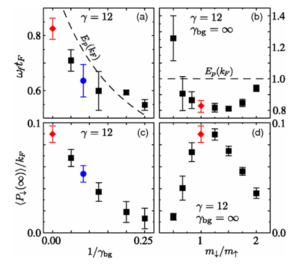Quantum Flutter: Signatures and Robustness
Category: Scientific HighlightsPublished in Physical Review Letters
ABSTRACT:
We investigate the motion of an impurity particle injected with finite velocity into an interacting one-dimensional quantum gas. Using large-scale numerical simulations based on matrix product states, we observe and quantitatively analyze long-lived oscillations of the impurity momentum around a nonzero saturation value, called quantum flutter. We show that the quantum flutter frequency is equal to the energy difference between two branches of collective excitations of the model. We propose an explanation of the finite saturation momentum of the impurity based on the properties of the edge of the excitation spectrum. Our results indicate that quantum flutter exists away from integrability and provide parameter regions in which it could be observed in experiments with ultracold atoms using currently available technology.

Figure: Quantum flutter for the nonintegrable cases of model (1). Top panels: Flutter frequency ωf. Data are obtained from TEBD simulations and error bars are obtained in the same way as for Fig. 3. The dashed line shows the plasmon energy at the Fermi momentum, EpðkFÞ. (a) ωf as a function of 1=γbg for m↓ ¼ m↑ and γ ¼ 12. (b) ωf as a function of m↓=m↑ for γbg ¼ ∞, γ ¼ 12, and Q ¼ 1.16kF. The quantum flutter frequency for the integrable Tonks-Girardeau model is indicated by the red diamond and for the integrable Yang-Gaudin model by the blue circle. Bottom panels: Saturated momentum hP↓ð∞Þi. Data used for panels (c) and (d) are the same as for (a) and (b). Error bars indicate the standard deviation of hP↓ðtÞi after the transient decay, t > 15tF.
Knap M., Mathy C.J.M., Ganahl M., Zvonarev M.B., Demler E. (2014), Quantum Flutter: Signatures and Robustness, Phys. Rev. Lett. 112, 015302. DOI:10.1103/PhysRevLett.112.015302, pdf
Other Recent ViCoM Publications
Sensengasse 8/12
A-1090 Vienna
AUSTRIA
T: +43-1-4277-51401
F: +43-1-4277-9514


